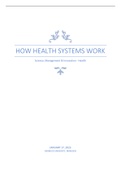Class notes
How Health Systems Work (NWI-FMT029) Summary
- Course
- Institution
Complete document of all the lectures of How health systems work (NWI-FMT029), for students following the Science, Management and Innovation tract focussing on health. Exam date: .
[Show more]




